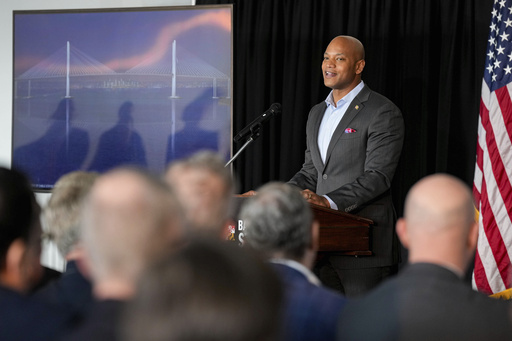SPARROWS POINT, Md. — Nearly a year following the catastrophic failure of Baltimore’s Francis Scott Key Bridge, Maryland officials presented plans for its successor on Tuesday. This new bridge design will be higher and equipped with enhanced safeguards against potential ship collisions.
Expected to be completed by 2028, this will be the state’s first cable-stayed bridge, projected to cost around $1.7 billion. Designed with elegance, state officials believe it will transform Baltimore’s skyline, symbolizing resilience, advancement, and economic development. The design showcases two prominent towers with cables extending downwards to support the deck.
“Today marks a significant milestone for Maryland,” stated Governor Wes Moore during a news conference. “However, we must remember that this achievement emerged from a tragic event.”
The original Key Bridge spanned 1.6 miles (2.6 kilometers) across the entrance to Baltimore’s harbor and took five years to construct, opening in 1977. It served as a critical link for various port-related industrial areas around Baltimore, enabling drivers to avoid congested downtown routes.
The bridge’s demise occurred when a large container ship experienced a loss of power and crashed into one of its support columns. The unfortunate incident on March 26 resulted in the death of six construction workers who were repairing potholes at the time of the collapse. Following the disaster, Baltimore’s port remained closed for several months, leading to ongoing traffic issues for motorists throughout the region.
Authorities swiftly committed to rebuilding the bridge, acknowledging its importance as both a historic landmark and a key transportation route. Current plans entail removing the remaining structural elements this spring, which will be followed by the actual construction of the new bridge.
The news conference was hosted at Tradepoint Atlantic, a significant shipping center that played a crucial role in recovery operations after the incident. This site is currently being transformed from a former Bethlehem Steel plant, located just northeast of Baltimore, as maritime shipping continues to drive the regional economy.
“Maryland connects America to the world, facilitating trade from Michigan to Louisiana, and distributing agricultural equipment from the East Coast to the heartland,” Governor Moore remarked. “Commerce is fundamental to our state’s identity, and we will keep investing in initiatives that stand in line with our legacy.”
In August, the state allocated a $73 million contract for the initial phase of the reconstruction process to Kiewit Infrastructure, a leading construction and engineering company. Officials outlined that the project would progress in two stages, beginning with crucial design work and preparatory efforts prior to construction. Governor Moore also assured that the project would provide employment opportunities for numerous Maryland residents throughout its duration.
Maryland Transportation Secretary Paul Wiedefeld emphasized that the new design will incorporate state-of-the-art pier protection technology, which is increasingly vital as ships grow in size and carry larger cargo loads. Additionally, the bridge height will be increased to allow for greater clearance. He noted that the plans take into account both the budget and the construction timeline for the project.
“This bridge is not just aesthetically pleasing; it will serve as a vital infrastructure component for a busy city,” Wiedefeld added.
The federal government has committed to financing the entire reconstruction expenses after Congress passed a recent spending bill that included funding for the endeavor. Officials expect that federal taxpayers will eventually recover their costs through insurance claims and damages; however, this process may take time. A wide-ranging civil lawsuit will eventually determine liability in what could become one of the priciest maritime disasters in U.S. history.
The National Transportation Safety Board has yet to release its conclusive report on the bridge’s failure, but initial findings suggest that a malfunctioning cable in the ship’s electrical switchboard may have contributed to its power failure. Federal agents also boarded the cargo ship Dali last year as part of an ongoing criminal investigation into the incident.



